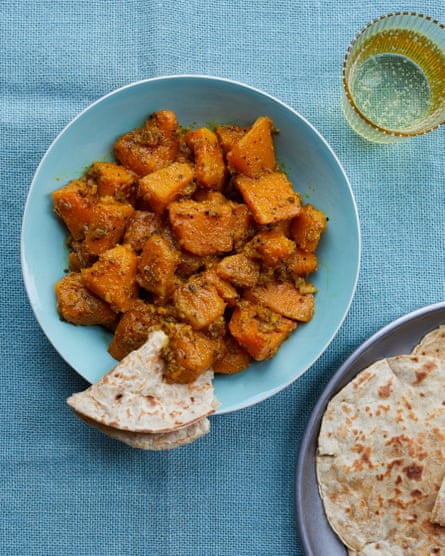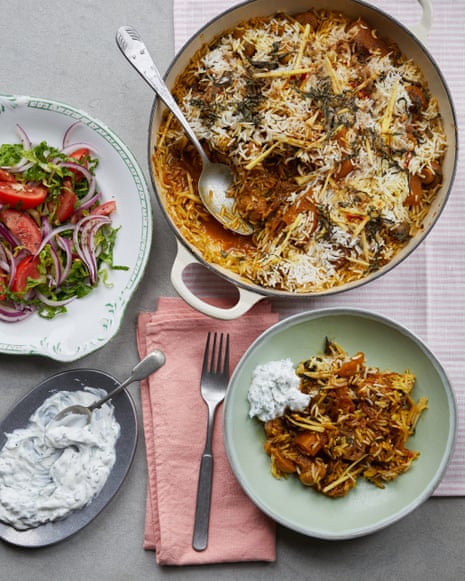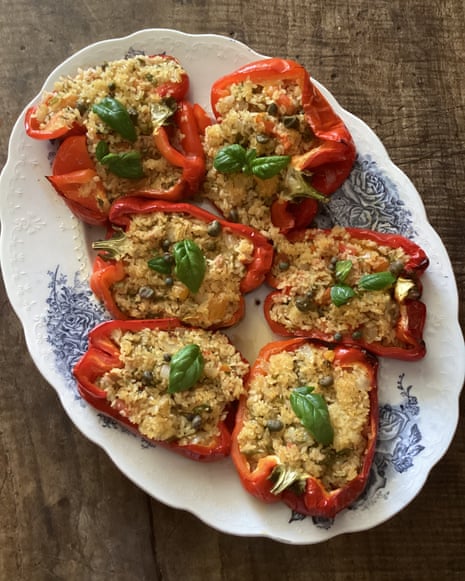Squash is having its moment as the rainy season slowly winds down across Nigeria. In many Nigerian homes, this is the season when hearty, warming dishes are craved most, whether in the form of thick soups, stews, or comforting rice meals. Across West Africa, creative cooks are always experimenting with local produce, but the global trend for cozy, spice-rich meals is unmistakable. With the increasing embrace of diverse culinary inspirations in cities like Lagos, Abuja and Accra, dishes influenced by India’s rich culinary legacy—especially biryanis and spicy stir-frys—are making their mark.
Rajasthani-style stir-fried squash and a soulful mushroom and squash biryani—both heavy on ginger, chili, and fragrant spices—offer a fresh take on vegetable-centric cooking. Interwoven with the earthiness of squash and mushrooms, and heightened with bold aromatics, these recipes bring together flavors that resonate. In line with the bold, aromatic food culture of Nigeria, these dishes fit beautifully into the menu of any West African kitchen.
Mushroom and Squash Biryani: A Spice-Infused Comfort Dish
October is recognized globally for its celebration of curries, with events like National Curry Week kicking off early in the month. This period is perfect to introduce or revisit one-pot rice sensations like biryani—dishes that are both accessible and deeply satisfying.
For Nigerian and Ghanaian food lovers in search of a crowd-pleaser, this biryani is a must—nourishing, spice-rich, and reminiscent of the beloved jollof rice in terms of technique and communal appeal. Much like jollof, biryani can be prepared in advance and then layered and baked just before serving, making it ideal for Sunday gatherings or festive occasions.
Preparation Time: 20 minutes
Cooking Time: 2 hours
Serves: 4
Ingredients for the Squash and Mushroom Gravy
4 tbsp ghee or butter
1 tsp cumin seeds
2 dried bay leaves
4 cloves
450g white onions, peeled and thinly sliced
3 green bird’s eye chillies, slit open lengthways (local ata rodo can work for those who love heat)
5cm fresh ginger, peeled and cut into matchsticks
2 tbsp tomato puree
¼ tsp mild chili powder or kashmiri chili powder (suya pepper can substitute for extra kick)
1 tsp ground turmeric
2 tsp coriander powder
1 heaped tbsp Greek yoghurt
300g butternut squash, diced (local pumpkin or ugu squash are perfect substitutes)
300g button mushrooms, cleaned and halved
400ml vegetable stock or water
Salt, to taste
2 tbsp chopped coriander for garnish (scent leaf or parsley if preferred)
For the Rice
200g basmati rice
2 bay leaves
4 green cardamom pods
A pinch of salt
For the Biryani Assembly
2 tbsp melted ghee
A generous pinch of saffron threads, soaked in 3 tbsp warm water
1¼cm piece fresh ginger, peeled and sliced into matchsticks
3 tbsp finely chopped fresh mint (or scent leaf for a unique twist)
1 tsp ground cardamom powder
1 tsp garam masala
Raita and salad, for serving
Step-by-Step Method
1. Prepare the Gravy: In a large pot or deep saucepan, melt the ghee over medium heat. Sizzle the cumin seeds, bay leaves, and cloves for several seconds. Mix in the onions and cook, stirring regularly, for about 30–35 minutes until soft and caramelized. Once the onions begin to brown, set half aside—these will add extra flavor and texture when layering the biryani.
2. With the rest of the onions in the pan, add the green chilies and ginger and fry briefly. Stir in the tomato puree, chili powder, turmeric, and coriander powder. Fry for another minute on low heat. Blend in the yogurt and cook for another two minutes to build up the creamy base.
3. Fold in the butternut squash and mushrooms, making sure they are coated with the rich spices. Sauté for about three minutes. Add the vegetable stock or water, season with salt, and bring the mixture to a boil. Once boiling, reduce the heat, cover, and allow to simmer for 18–20 minutes. Stir halfway through to prevent sticking. Remove from heat and top with chopped coriander.
4. Cook the Rice: While the gravy simmers, preheat the oven to 200°C (180°C fan)/390°F/gas 6. Thoroughly rinse the basmati rice. Cook in a saucepan with a liter of water, the bay leaves, cardamom pods, and salt for 10–12 minutes until three-quarters done. Drain well to avoid sogginess.
5. Assemble Your Biryani: In a deep casserole dish (with a tight-fitting lid), brush a tablespoon of melted ghee across the bottom. Ladle in half the vegetable curry, then layer half the cooked rice on top. Sprinkle with half of the saffron water, ginger, mint, ground cardamom, and garam masala, along with some of the reserved caramelized onions. Repeat with the remaining curry, rice, spices, and onions.
6. Cover tightly with baking paper, then the lid, and bake on the oven’s middle shelf for 15–17 minutes. Let the flavors infuse the rice for a deeply aromatic finish. Allow it to rest, still covered, for another 10 minutes before serving. Enjoy with raita (savory yoghurt sauce) and a fresh salad.
Nigerian Adaptation Tips: Swap Greek yoghurt for local Fura da Nono, use pumpkin or ugu variety squash, and blend in scent leaf for an unmistakably West African twist. Serve alongside grilled fish or spiced chicken for a celebratory gathering.
Rajasthani Achari Kaddu: Stir-Fried Squash with Pickling Spices

Maunika Gowardhan’s Rajasthani achari kaddu, or squash cooked with pickling spices.
The term “achari” is rooted in the Hindi word “achar” (pickle), and refers to a complex blend of pickling spices familiar in North India. These spices—including mustard, fennel, fenugreek, cumin, asafoetida, and nigella—are not reserved for pickles only: they bring depth and unique fragrance to stews, stir-fries, and, increasingly, to fusion dishes loved in cosmopolitan African homes.
Within Nigeria and Ghana, cooks often substitute these with locally available spices. According to Lagos-based food blogger Tolu Fashanu, “I use uda (grains of Selim) or alligator pepper with local mustard for that authentic, peppery flavor when making fusion Indian-inspired dishes.”
Preparation Time: 10 minutes
Cooking Time: 30 minutes
Serves: 4
Ingredients
1 tsp black mustard seeds
½ tsp fenugreek seeds
1 tsp fennel seeds
4 tbsp vegetable oil (groundnut or palm oil for local flavor)
A pinch of asafoetida (optional)
5cm fresh ginger, finely chopped
750g squash or pumpkin, cut into small cubes
1 tsp mild chili powder
½ tsp ground turmeric
Salt, to taste
1 tbsp jaggery (or local unrefined brown sugar—loko sugar is a good alternative)
2 tsp dried mango powder (locally-sourced lemon or lime zest can substitute)
Method
1. Crush the mustard, fenugreek, and fennel seeds coarsely with a mortar and pestle.
2. Heat oil in a large frying pan or kadhai over medium flame. Add the crushed spices and the asafoetida, stirring for a few seconds until fragrant.
3. Stir in the fresh ginger and fry for about a minute.
4. Add the cubed squash, chili powder, and turmeric. Stir-fry for five minutes, letting the spices infuse the squash.
5. Pour in 50ml water, season with salt, and bring to a boil. Reduce heat, cover, and cook for 20 minutes, stirring once halfway through.
6. Add the jaggery (or local brown sugar), then sprinkle in the dried mango powder or zest. Toss well and serve warm, ideally with soft chapatis, agege bread, or naan.
Pro Tip for West African Kitchens: Replace jaggery with koko (sorghum molasses) or local honey for complexity. Serve alongside grilled suya, moin moin, or eba for a Nigerian-fusion feast that celebrates seasonal produce.
-
According to cook and food writer Maunika Gowardhan, author of the cookbook Tandoori Home Cooking: Over 70 Classic Indian Tandoori Recipes to Cook at Home, depth and balance come from using quality spices and fresh local ingredients. Her work reflects a growing global interest in food heritage and the adaptation of classic recipes using locally available produce, which West African chefs and home cooks can embrace for their own kitchens.
These recipes highlight how global culinary traditions—whether Indian, Nigerian, or Ghanaian—can merge to create new favorites bursting with flavor and comfort. In many Nigerian families, squash is often overlooked, but as local chefs note, its versatility—from sweet stir-fries to rich, layered rice dishes—means it can play a leading role in vibrant, fusion meals all year long.
So, have you experimented with squash or unique global spice blends in your kitchen? What favorite Nigerian classics would you like to see with an international twist? Share your thoughts below and inspire our culinary community!
Have a recipe or family food story you want to share or even sell? We’d love to hear from you! Email us at story@nowahalazone.com to get your culinary creation featured or to discuss story sales.
For more food features, recipe tips, and community spotlights, follow us on Facebook, X (Twitter), and Instagram.
Craving more? Drop a comment with your questions, food hacks, or favorite fusion dishes, and don’t forget to check back for delicious updates!










